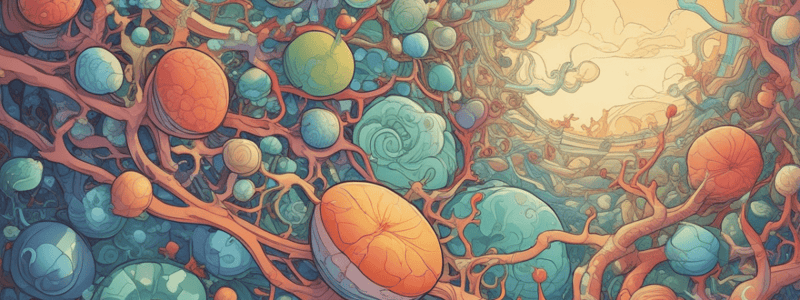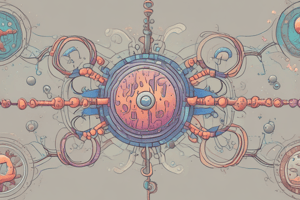Podcast
Questions and Answers
What is the primary source of glucose for glycolysis?
What is the primary source of glucose for glycolysis?
- DNA
- Energy-storage polysaccharides (correct)
- Protein
- Lipid
What is the end product of pyruvate in anaerobic organisms?
What is the end product of pyruvate in anaerobic organisms?
- Lactate
- Acetyl-CoA
- Ethanol and carbon dioxide (correct)
- All of the above
What is the primary function of the citric acid cycle?
What is the primary function of the citric acid cycle?
- To generate ATP through substrate-level phosphorylation
- To reduce pyruvate to lactate
- To synthesize glucose from pyruvate
- To oxidize simple carbon compounds to CO2 (correct)
What is the role of electron transport and oxidative phosphorylation in the citric acid cycle?
What is the role of electron transport and oxidative phosphorylation in the citric acid cycle?
What is the primary difference between anaerobic and aerobic organisms?
What is the primary difference between anaerobic and aerobic organisms?
What is the product of glycolysis in aerobic organisms?
What is the product of glycolysis in aerobic organisms?
What is the role of intermediary metabolism?
What is the role of intermediary metabolism?
What is the fate of pyruvate in oxidative metabolism?
What is the fate of pyruvate in oxidative metabolism?
What is the primary function of glycolysis in anaerobic carbohydrate metabolism?
What is the primary function of glycolysis in anaerobic carbohydrate metabolism?
Which of the following pathways is involved in the synthesis of polysaccharides such as glycogen?
Which of the following pathways is involved in the synthesis of polysaccharides such as glycogen?
What is the chemical strategy of glycolysis condensed into?
What is the chemical strategy of glycolysis condensed into?
What is the route of ATP synthesis in glycolysis?
What is the route of ATP synthesis in glycolysis?
What are the three stages of metabolism identified in the glycolytic pathway?
What are the three stages of metabolism identified in the glycolytic pathway?
What is the primary function of the pentose phosphate pathway?
What is the primary function of the pentose phosphate pathway?
What is the outcome of the three processes of glycolysis?
What is the outcome of the three processes of glycolysis?
What is the product of glycolysis that provides fuel for aerobic energy-generating pathways?
What is the product of glycolysis that provides fuel for aerobic energy-generating pathways?
What is the purpose of compartmentation and allosteric control in metabolic processes?
What is the purpose of compartmentation and allosteric control in metabolic processes?
What is the result of the interconversion of fructose-6-phosphate with fructose-1,6-bisphosphate in carbohydrate metabolism?
What is the result of the interconversion of fructose-6-phosphate with fructose-1,6-bisphosphate in carbohydrate metabolism?
What is the primary function of nucleophiles in biochemical reactions involving carbonyl groups?
What is the primary function of nucleophiles in biochemical reactions involving carbonyl groups?
What is the primary electron acceptor in the oxidation of fuel molecules such as glucose?
What is the primary electron acceptor in the oxidation of fuel molecules such as glucose?
What is the type of oxidation that occurs when an alcohol loses a pair of electrons and two hydrogen atoms?
What is the type of oxidation that occurs when an alcohol loses a pair of electrons and two hydrogen atoms?
What is the primary source of energy for most cells?
What is the primary source of energy for most cells?
What is true about the electron acceptors in some microorganisms?
What is true about the electron acceptors in some microorganisms?
What is the primary role of dehydrogenases in metabolic reactions?
What is the primary role of dehydrogenases in metabolic reactions?
What is the primary product of the digestion of neutral fat and most phospholipids?
What is the primary product of the digestion of neutral fat and most phospholipids?
What is the enzyme that acts on glycerol in the liver to convert it into the glycolytic pathway?
What is the enzyme that acts on glycerol in the liver to convert it into the glycolytic pathway?
What is the primary source of glucose in animal metabolism?
What is the primary source of glucose in animal metabolism?
What is the enzyme that breaks down glycogen stores in skeletal muscle and liver?
What is the enzyme that breaks down glycogen stores in skeletal muscle and liver?
What is the product of the action of glycogen phosphorylase on glycogen stores?
What is the product of the action of glycogen phosphorylase on glycogen stores?
What is the type of reaction that occurs in the breakdown of glycogen stores?
What is the type of reaction that occurs in the breakdown of glycogen stores?
What is the result of the cleavage of a glycosidic bond by phosphorolysis?
What is the result of the cleavage of a glycosidic bond by phosphorolysis?
What is the primary way in which dietary polysaccharides are metabolized?
What is the primary way in which dietary polysaccharides are metabolized?
What is the energy yield from glycolysis per glucose molecule?
What is the energy yield from glycolysis per glucose molecule?
What is the characteristic of the three enzymes that catalyze highly exergonic reactions in anaerobic glycolysis?
What is the characteristic of the three enzymes that catalyze highly exergonic reactions in anaerobic glycolysis?
Which tissues are the primary gluconeogenic tissues in the human body?
Which tissues are the primary gluconeogenic tissues in the human body?
What is the purpose of gluconeogenesis in the human body?
What is the purpose of gluconeogenesis in the human body?
What is the bypass reaction in gluconeogenesis that converts pyruvate to phosphoenolpyruvate?
What is the bypass reaction in gluconeogenesis that converts pyruvate to phosphoenolpyruvate?
What is the characteristic of the reactions in anaerobic glycolysis?
What is the characteristic of the reactions in anaerobic glycolysis?
What is the energy source for brain, skeletal muscle, kidney medulla, erythrocytes, and testes?
What is the energy source for brain, skeletal muscle, kidney medulla, erythrocytes, and testes?
What is the significance of gluconeogenesis in the human body?
What is the significance of gluconeogenesis in the human body?
Flashcards are hidden until you start studying
Study Notes
Metabolism Overview
- Intermediary metabolism involves biosynthesis, utilization, and degradation of low-molecular-weight compounds (intermediates)
- Metabolic energy can be derived from anaerobic environments, where molecular oxygen is not involved
Glycolysis
- A stage 2 pathway for degradation of carbohydrates, occurring in both aerobic and anaerobic cells
- Major input is glucose, derived from energy-storage polysaccharides or dietary carbohydrates
- Leads to pyruvate, a three-carbon a-keto acid
- In anaerobic organisms, pyruvate is reduced to various products, such as lactate or ethanol plus carbon dioxide (fermentations)
Oxidative Metabolism (Respiration)
- Pyruvate is oxidized to a metabolically activated two-carbon fragment, acetyl-CoA
- The citric acid cycle is the principal stage 3 pathway in aerobic organisms, accepting simple carbon compounds and oxidizing them to CO2
- Oxidative reactions in the citric acid cycle generate reduced electron carriers, driving ATP biosynthesis through electron transport and oxidative phosphorylation
Compartmentation and Allosteric Control
- Prevents futile cycles, which waste energy
- Regulation of anabolic and catabolic processes occurs through compartmentation and allosteric control
Biochemical Reaction Types
- Much of biological chemistry involves the carbonyl group, found in most biological molecules
- Redox chemistry lies at the core of metabolism, involving reversible electron transfer from a donor (reductant) to an acceptor (oxidant)
Energy Production
- Most biological energy is derived from the oxidation of fuel molecules, such as glucose
- Oxidation-reduction (redox) chemistry is essential for energy production
Anaerobic Metabolism
- Many microorganisms can or must live anaerobically, using substances other than oxygen as terminal electron acceptors
- Anaerobic metabolism involves the oxidation of reduced metabolites, with oxygen as the final electron acceptor
Carbohydrate Metabolism
- Catabolic and anabolic processes in anaerobic carbohydrate metabolism involve glycolysis, gluconeogenesis, and glycogen metabolism
- Glycolysis generates ATP anaerobically and provides fuel for aerobic energy-generating pathways
Glycolysis: An Overview
- The two phases of glycolysis are:
- Addition of phosphoryl groups to glucose, yielding compounds with low phosphate group-transfer potential
- Conversion of these low phosphate group-transfer potential intermediates into compounds with high phosphate group-transfer potential
- Chemical coupling of the energy-yielding hydrolysis of these high phosphate group-transfer potential compounds to the synthesis of ATP
Reactions of Glycolysis
- ATP is synthesized via substrate-level phosphorylation
- Glycolysis produces ATP via substrate-level phosphorylation
Energy and Electron Balance Sheets
- Glycolysis, which yields 2 ATP per glucose, is fast but releases only a small fraction of the energy available from glucose
- Energy profile of anaerobic glycolysis shows that most reactions function at or near equilibrium and are freely reversible in vivo
Gluconeogenesis
- Synthesis of glucose from noncarbohydrate precursors is essential for maintaining blood glucose levels within acceptable limits
- Liver and kidney cortex are the primary gluconeogenic tissues
- Gluconeogenesis uses specific enzymes to bypass three irreversible reactions of glycolysis
Polysaccharide Metabolism
- In animal metabolism, two primary sources of glucose are derived from polysaccharides:
- Digestion of dietary polysaccharides, chiefly starch from plant foodstuffs and glycogen from meat
- Mobilization of the animal's own glycogen reserves
- Breakdown of glycogen stores into usable energy involves sequential phosphorolytic cleavages of bonds, catalyzed by glycogen phosphorylase
Studying That Suits You
Use AI to generate personalized quizzes and flashcards to suit your learning preferences.




